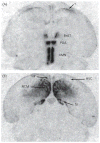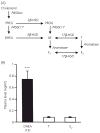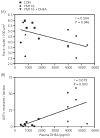Testosterone and aggression: Berthold, birds and beyond
- PMID: 16774503
- PMCID: PMC2954190
- DOI: 10.1111/j.1365-2826.2006.01440.x
Testosterone and aggression: Berthold, birds and beyond
Abstract
Berthold's classic study of domesticated roosters in 1849 demonstrated that testicular secretions are necessary for the normal expression of aggressive behaviour. Although this conclusion is undoubtedly correct, field studies of wild songbirds have yielded important modifications and limitations of Berthold's original hypothesis. For example, studies of the North American song sparrow (Melospiza melodia) during the breeding season reveal that not only does testosterone increase aggression, but aggressive interactions also increase plasma testosterone levels. Furthermore, in winter, nonbreeding song sparrows have low plasma testosterone levels but are very aggressive, and castration of nonbreeding song sparrows does not decrease aggression. Interestingly, an aromatase inhibitor (fadrozole) does decrease male aggression in the nonbreeding season, and the effects of fadrozole can be rescued with oestradiol. In winter, dehydroepiandrosterone (DHEA) from the periphery can be metabolised within the brain to supply oestradiol to specific neural circuits. Additionally, oestradiol might be synthesised de novo from cholesterol entirely within the brain. These mechanisms may have evolved to avoid the 'costs' of circulating testosterone in the nonbreeding season. Recent studies in tropical birds, hamsters, and humans suggest that these neuroendocrine mechanisms are important for the control of aggression in many vertebrate species.
Figures







Similar articles
-
Dehydroepiandrosterone in songbird plasma: seasonal regulation and relationship to territorial aggression.Gen Comp Endocrinol. 2001 Aug;123(2):144-55. doi: 10.1006/gcen.2001.7657. Gen Comp Endocrinol. 2001. PMID: 11482935
-
Acute and chronic effects of an aromatase inhibitor on territorial aggression in breeding and nonbreeding male song sparrows.J Comp Physiol A. 2000 Jul-Aug;186(7-8):759-69. doi: 10.1007/s003590000129. J Comp Physiol A. 2000. PMID: 11016791
-
Dehydroepiandrosterone Heightens Aggression and Increases Androgen Receptor and Aromatase mRNA Expression in the Brain of a Male Songbird.J Neuroendocrinol. 2016 Dec;28(12):n/a. doi: 10.1111/jne.12443. J Neuroendocrinol. 2016. PMID: 27805753 Free PMC article.
-
Novel mechanisms for neuroendocrine regulation of aggression.Front Neuroendocrinol. 2008 Oct;29(4):476-89. doi: 10.1016/j.yfrne.2007.12.003. Epub 2008 Jan 3. Front Neuroendocrinol. 2008. PMID: 18280561 Review.
-
DHEA effects on brain and behavior: insights from comparative studies of aggression.J Steroid Biochem Mol Biol. 2015 Jan;145:261-72. doi: 10.1016/j.jsbmb.2014.05.011. Epub 2014 Jun 11. J Steroid Biochem Mol Biol. 2015. PMID: 24928552 Review.
Cited by
-
Multiple measures elucidate glucocorticoid responses to environmental variation in predation threat.Oecologia. 2011 Jul;166(3):607-14. doi: 10.1007/s00442-011-1915-2. Epub 2011 Jan 30. Oecologia. 2011. PMID: 21279653
-
Biological Clocks and Rhythms of Anger and Aggression.Front Behav Neurosci. 2018 Jan 23;12:4. doi: 10.3389/fnbeh.2018.00004. eCollection 2018. Front Behav Neurosci. 2018. PMID: 29410618 Free PMC article. Review.
-
Gut microbiota is associated with the effect of photoperiod on seasonal breeding in male Brandt's voles (Lasiopodomys brandtii).Microbiome. 2022 Nov 15;10(1):194. doi: 10.1186/s40168-022-01381-1. Microbiome. 2022. PMID: 36376894 Free PMC article.
-
Contextual modulation of social and endocrine correlates of fitness: insights from the life history of a sex changing fish.Front Neurosci. 2015 Feb 3;9:8. doi: 10.3389/fnins.2015.00008. eCollection 2015. Front Neurosci. 2015. PMID: 25691855 Free PMC article. Review.
-
Environmental enrichment preceding early adulthood methylphenidate treatment leads to long term increase of corticosterone and testosterone in the rat.PLoS One. 2011;6(7):e22059. doi: 10.1371/journal.pone.0022059. Epub 2011 Jul 15. PLoS One. 2011. PMID: 21789212 Free PMC article.
References
-
- Wingfield JC, Ball GF, Dufty AM, Hegner RE, Ramenofsky M. Testosterone and aggression in birds. Am Sci. 1987;75:602–608.
-
- Schlinger BA, Callard GV. Aggressive behavior in birds: an experimental model for studies of brain–steroid interactions. Comp Biochem Physiol A. 1990;97:307–316. - PubMed
-
- Harding CF, Follett BK. Hormone changes triggered by aggression in a natural population of blackbirds. Science. 1979;203:918–920. - PubMed
-
- Konishi M, Emlen ST, Ricklefs RE, Wingfield JC. Contributions of bird studies to biology. Science. 1989;246:465–472. - PubMed
Publication types
MeSH terms
Substances
Grants and funding
LinkOut - more resources
Full Text Sources

